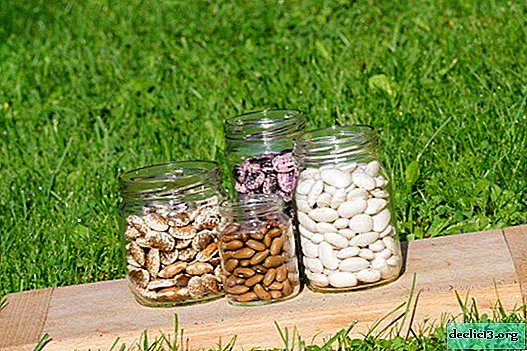Variety of Chinese radish "Fang of an elephant": a description of the hybrid, the nuances of growing and application

Radish is probably the most popular healthy vegetable, used fresh in any kitchen.
Different varieties of radish are slightly different from each other in the diverse shape and color of the pulp.
Radish has excellent taste, devoid of the bitterness of ordinary radish.
The most favorite among farmers is the Elephant Fang variety. The article details this variety.
Detailed description and description of the hybrid
"Elephant Fang" - a hybrid obtained by crossing varieties of Chinese radish. The vegetable belongs to the Cruciferous family, a type of forehead. The plant is grown by seed, recommended for cultivation in the Central regions of Russia.Radish belongs to the varieties of medium term fruiting (mid-season). The growing season of the culture is 70-80 days. The rosette of the variety is loose, 45-50 cm high. The pulp has a pleasant taste, does not bite. The fruits have a rich composition of useful microelements that are not lost during long-term storage. Root crops are elevated above the surface of the soil, which is very convenient when removing them from the ground during harvesting. The variety tolerates dry summers well.
Appearance
Root crops have a smooth surface, cylindrical in shape, elongated, the length of vegetables is 25-35 cm, individual specimens reach 50 cm, the width at the base is 7-8 cm. The skin color is white with a greenish tint at the base. The pulp is white, juicy, crisp. Weight 350-550 g. The variety has a loose, spreading rosette. The leaves are deep green, narrow, the edges are dissected, the surface is pubescent.



When to plant?
"Elephant Fang" refers to mid-season varieties, it is planted in spring or summer. During spring planting, seeds are planted from late April to the first half of May. In summer, landing is carried out from mid-July to August.
What is the yield per 1 ha?
Elephant Fang is a high-yielding variety. With proper agricultural technology from 1 sq. M, they collect 3.5-5 kg of radish.
Where is it recommended to grow?
The variety is recommended for cultivation in the open ground. In the northern regions of the country with difficult climatic conditions, radish is grown in greenhouses.
Disease resistance
The variety has good immunity to diseases of the culture. With rapid warming and an increase in daylight, the variety may have peduncles, immediately remove them, since the flowering stops the formation of fruits.
To prevent flowering, some gardeners plant radish seeds in late July. It is believed that this way you can avoid the bloom of the culture.Ripening period
A variety with an average ripening period, the growing season is 70-80 days. The ripening period depends on the climatic conditions of the cultivation area of the radish.
What soil prefers?
 Radish "Elephant Fang" - unpretentious plant in growinggrows well on various types of soil. High yields are achieved on well-drained, fertile soils. The culture responds well to slightly acidic or neutral soils.
Radish "Elephant Fang" - unpretentious plant in growinggrows well on various types of soil. High yields are achieved on well-drained, fertile soils. The culture responds well to slightly acidic or neutral soils.
The site begins to prepare in the fall. Dig the soil to a depth of 25-30 cm, while introducing organic matter. In the spring before sowing, fertilizers are applied:
- potassium nitrate (30 g per 1 sq.m);
- urea (20 g per 1 sq.m);
- superphosphate (20 g per 1 sq.m);
- rotted compost (3 kg per 1 sq. m).
Breeding History
The birthplace of the Chinese radish is Japan. Breeding of the hybrid "Fang of an elephant" was done by breeders of the Kuban. The variety was entered in the State Register in 1977. The originator of the variety is Intersemya LLC.
What is the difference from other varieties of Chinese vegetable?
"Elephant Fang" is different from other varieties:
- larger sizes;
- the pulp of root vegetables contains a small amount of radish oil, so the taste of root vegetables is softer, without sharp bitterness;
- long shelf life;
- during winter storage keeps useful properties.
Subsorta and hybrids
The Elephant Fang variety has several sub-varieties.
Red Meath

Mid-season grade. Rosette erect, leaf edges serrated, dark green. Root crops are rounded with greenish bases. Fruit weight reaches 200 g. The pulp is reddish, juicy.
We offer you to watch a video about the variety Red Meat:
Beauty of Moscow Region

Mid-season grade. Root crops are round and oblong. Reddish radish with a purple tint, the base is deep red. The weight of vegetables is 160-200 g. The pulp is white, crispy, with a slight sharpness.
Oktyabrskaya-2

Hybrid variety. Ripening period is 60-75 days. The root crop is oblong, cylindrical in shape. The peel is white, the top is a green hue. The pulp is white, juicy, without bitterness.
Advantages and disadvantages
The variety has many advantages:
- In root crops, a high content of vitamins, carotene, amino acids, potassium, calcium.
- A vegetable is useful for normalizing the functioning of the gastrointestinal tract.
- Radish juice helps to dissolve small stones in the gall bladder, kidneys.
- Radish essential oils have an anti-inflammatory effect.
- It is used in the treatment of arthritis, radiculitis.
Contraindications for use are:
- Use with caution in food to pregnant women.
- It is not recommended to eat raw vegetables during lactation.
- With diseases of the stomach, kidneys, eat only boiled or stewed vegetables.
Why and where is it used?
The variety is used fresh, salted, boiled. Radish is a low-calorie vegetable, used as a dietary product. Fresh young leaves are added to vegetable salads. Tops are used for pet food.Radish is widely used to treat various diseases. Radish juice with honey helps with colds. Due to the significant content of nutrients, the vegetable strengthens the immune system.
Growing
 Culture is planted in late April:
Culture is planted in late April:
- Before sowing, the seed material is pre-sorted. Damaged, unripe seeds are discarded.
- Furrows are made at the prepared site at a distance of 25-35 cm. Seeds are laid in holes to a depth of 1.5-2 cm for 2-3 pieces. Between the seeds leave a gap of 20-25 cm.
- Wells with seeds are moistened, covered with soil and covered with a film.
- When seedlings appear, the film is removed.
- After the formation of 2-3 pairs of leaves on the sprouts, the plants are thinned out, removing weaker sprouts.
- Throughout the growing season, the soil is regularly loosened, weeds are weeded, watered, and seedlings are fertilized.
With insufficient watering, the flesh of root crops becomes coarse, bitter. Watering should be carried out regularly. Irregular watering leads to cracking of root crops.
Feeding is carried out 2-3 times per season. The first top dressing is performed at the beginning of the growing season, introducing nitrogen fertilizers (urea, ammonium sulfate). The second top dressing is necessary during the formation of root crops. For this, potash and phosphorus fertilizers are introduced (potassium sulfate, superphosphate).
Mineral fertilizers alternate with organic (wood ash, compost).
Harvesting and storage
Harvesting begins in the fall and ends before the onset of the first frost.
If the roots are overexposed in the soil, voids form in the pulp, the fruits lose their juiciness.For harvesting, choose dry weather. The root crops of the variety protrude above the surface of the soil, they are easy to stretch, holding on to the tops. When grown on heavy soils, vegetables are dug up with a shovel. The tops are twisted, leaving 1.5-2 cm.
Fruits are laid out in a dry room to dry for 4-5 days, then transferred to a vegetable store with an air temperature of 1-2 ° C, humidity 80-85%. Store radish in a wooden container, laying between layers of sand. During storage periodically inspect vegetables.
Diseases and Pests

- The culture is often attacked by cruciferous fleas - small jumping bugs that gnaw holes in the leaves. The invasion of pests will eliminate pollination of plants with ash and tobacco dust (1: 1). In case of severe damage, the plants are sprayed with the preparations "Decis", "Arrivo".
- The fight against slugs that feed on foliage is carried out using the drug "Actellik".
- From aphids will help the composition of liquid soap and insecticide "Confidor" in a ratio of 1: 2.
- To prevent pests, the area after sowing is treated with ash and tobacco chips.
To prevent the occurrence of parasitic insects, one should not allow thickening of the crop.
The disease grade "Elephant Fang" is resistant.
Similar varieties
- White Fang - mid-season grade. The shape and color of the radish are the same as the "Elephant Fang". The taste is sweetish, with a touch of bitterness.
- Big bull - domestic hybrid. Root crops are also oblong with a sharp tip. The flesh is crispy.
- Russian size - oblong fruit, color and smooth surface are the same as that of "Elephant Fang". The variety is high-yielding, early ripe, does not lose juiciness during storage.
The variety of Chinese radish "Elephant Fang" gives high yields, unpretentious care, resistant to disease. Vegetables retain good qualities during winter storage. The variety is suitable for cultivation in almost all regions of the country.
Useful video
We offer you to watch a video about the variety of radish Elephant Fang:

















